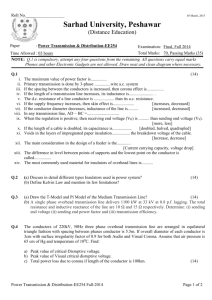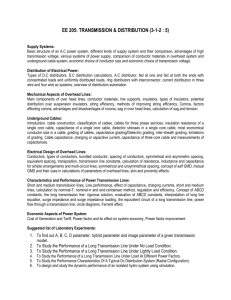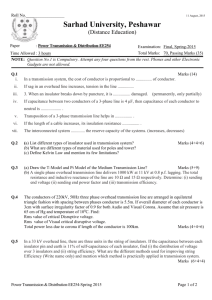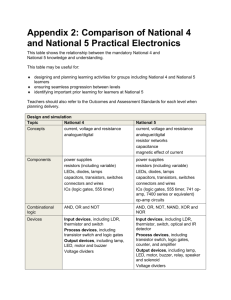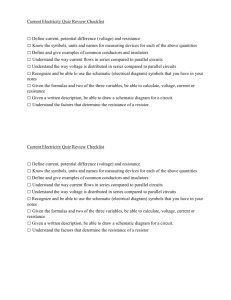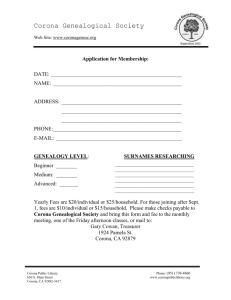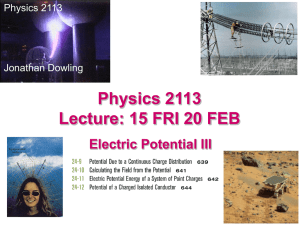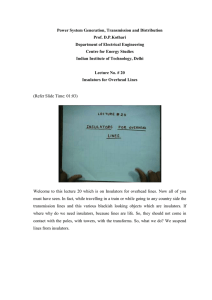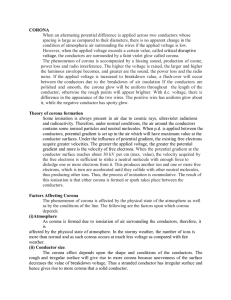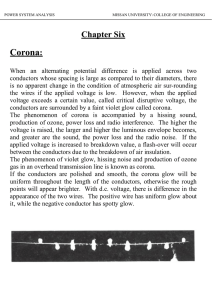R09 SET-1 Code No: 09A50203 B. Tech III Year I Semester
advertisement
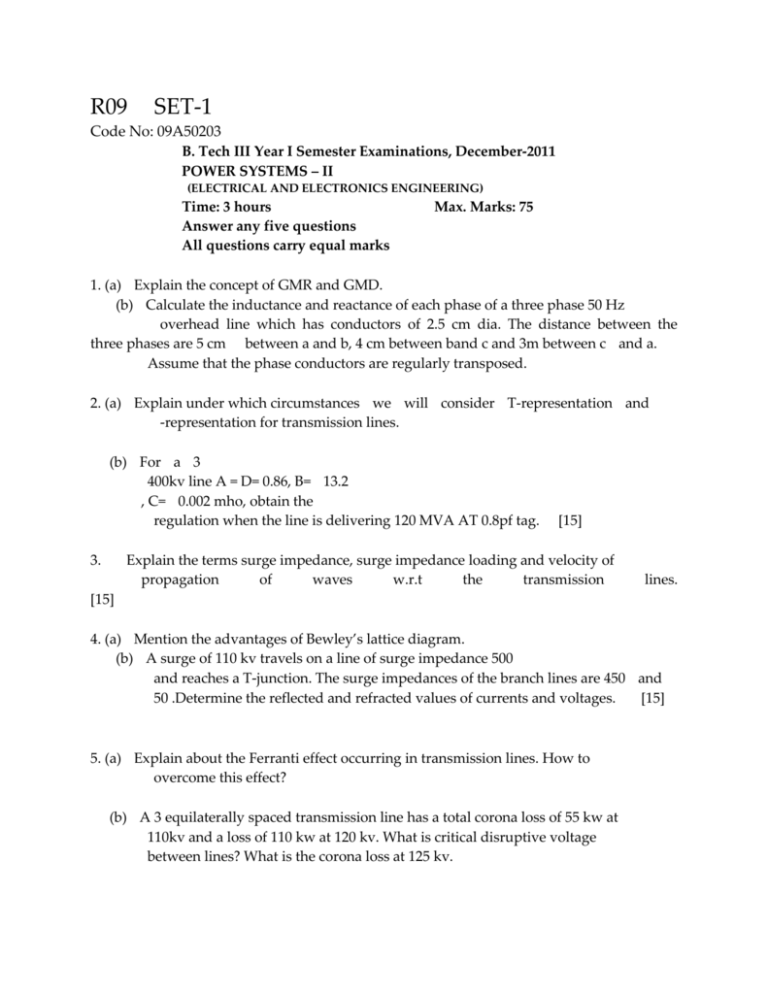
R09 SET-1 Code No: 09A50203 B. Tech III Year I Semester Examinations, December-2011 POWER SYSTEMS – II (ELECTRICAL AND ELECTRONICS ENGINEERING) Time: 3 hours Answer any five questions All questions carry equal marks Max. Marks: 75 1. (a) Explain the concept of GMR and GMD. (b) Calculate the inductance and reactance of each phase of a three phase 50 Hz overhead line which has conductors of 2.5 cm dia. The distance between the three phases are 5 cm between a and b, 4 cm between band c and 3m between c and a. Assume that the phase conductors are regularly transposed. 2. (a) Explain under which circumstances we will consider T-representation and -representation for transmission lines. (b) For a 3 400kv line A = D= 0.86, B= 13.2 , C= 0.002 mho, obtain the regulation when the line is delivering 120 MVA AT 0.8pf tag. 3. [15] Explain the terms surge impedance, surge impedance loading and velocity of propagation of waves w.r.t the transmission lines. [15] 4. (a) Mention the advantages of Bewley’s lattice diagram. (b) A surge of 110 kv travels on a line of surge impedance 500 and reaches a T-junction. The surge impedances of the branch lines are 450 and 50 .Determine the reflected and refracted values of currents and voltages. [15] 5. (a) Explain about the Ferranti effect occurring in transmission lines. How to overcome this effect? (b) A 3 equilaterally spaced transmission line has a total corona loss of 55 kw at 110kv and a loss of 110 kw at 120 kv. What is critical disruptive voltage between lines? What is the corona loss at 125 kv. 6. (a) Explain about various types of insulators used for overhead transmission lines. (b) Describe how static shielding improves string efficiency in transmission lines. 7. (a) Derive the equation for sag when the two supports are at equal heights. (b) Explain how stringing chart is useful in erecting the transmission line. 8. (a) Describe the constructing and working principle of a 3 core belted cable. (b) Explain the relative advantages and disadvantages of various types of grading procedures adopted in under ground cables. R09 SET-2 Code No: 09A50203 B. Tech III Year I Semester Examinations, December-2011 POWER SYSTEMS – II (ELECTRICAL AND ELECTRONICS ENGINEERING) Time: 3 hours Answer any five questions All questions carry equal marks Max. Marks: 75 1. (a) Derive the expression for capacitance of an unsymmetrical three phase system regularly transposed. (b) What is the effect of ground on transmission line capacitance? 2. (a) Explain the classification of transmission lines. (b) Derive the expression for regulation and efficiency of a medium line using end conductor method. Draw the phasor diagram. 3. Explain how long lines are represented by equivalent model. 4. Derive the expression for wave equation of a traveling wave. 5. (a) Explain the factors affecting corona loss in transmission lines. (b) A 3-, 220 k v, 50 Hz transmission line has equilateral triangular spacing of 2m side. The conductor diameter is 3 cm. The air density factor and surface irregularity factor are 0.95 and 0.83 respectively. Find critical disruptive voltage and corona loss per kilometer. 6. (a) Explain about various types of insulators used for overhead transmission lines. (b) A string of suspension insulators consists of three units. The capacitance between each pin and earth is 15% of the self capacitance of the unit. If the maximum peak voltage per unit is not to exceed 35kv, find the working voltage and string efficiency. 7. (a) What is a sag template? What are its advantages? (b) Calculate the minimum sag permissible for a 160 m span, 1 cm dia copper conductor allowing a maximum tensile stress of 2000 kg/cm2. Assume a windpressure of 4 kg/cm2 of projected area and ice coating of 1 cm. Specific gravity of copper is 8.9 gm/cm3. 8. (a) By means of a diagram describe the construction of a underground cable. (b) The inner and outer diameter of a cable are 3 cm and 8 cm respectively. The cable is insulated with two materials having permittivity of 5 and 3.5 with corresponding stresses of 38 kv/cm and 30kv /cm. calculate the radial thickness of each insulating layer and the safe working voltage of the cable. [15] R09 SET-3 Code No: 09A50203 B. Tech III Year I Semester Examinations, December-2011 POWER SYSTEMS – II (ELECTRICAL AND ELECTRONICS ENGINEERING) Time: 3 hours Answer any five questions All questions carry equal marks Max. Marks: 75 1. (a) Give the comparison between various types of conductors used for transmission systems. (b) Calculate the loop inductance of a single phase line with two parallel conductors spaced 3.5m a part. The diameter of each conductor is 1.5cm. 2. (a) Explain the classification of transmission lines. (b) Explain why ABCD parameters are used for evaluating performance of a transmission line. 3. Explain how long lines are represented by equivalent T model. 4. (a) Explain the terms attenuation, distortion, reflection and refraction coefficients w.r.t traveling waves. (b) Using Bewley’s Lattice diagram, represent the voltage and current waveforms of a short circuited line. 5. (a) Describe the phenomenon of corona occurring in transmission lines. How to reduce corona effect? (b) A 3 equilaterally spaced transmission line has a total corona loss of kw at 110 kv and 110kw at 120kv. What is critical disruptive voltage between lines? What is the corona loss at 125 kv. 6. (a) By mean of an example show how grading of units is done for suspension insulators. (b) Explain about the properties that any insulating materials should posses. 7. (a) Explain what is the effect of wind and ice on weight of the conductor. How are they accounted.? (b) For a overhead line span length is 185m, difference in levels of supports is 6.5m, conductor diameter 1.82cm, weight per unit length of conductor 1.5 kg and wind pressure of 39 kg/m2 of projected area. If the maximum tensile strength of the conductor is 4250 kg/cm2 and safety factor 5, calculate the sag. 8. (a) By mean of a diagram describe how inner sheath grading is provided in underground cables. (b) A cable has been insulated with two insulating materials having permittivity of 4 and 2.5 respectively. The inner and other diameters of the cable are 2.2cm and 7 cm. If the dielectric stress is 40 k v/ cm, calculate the radial thickness of each insulating layer and the safe working voltage of the cable. R09 SET-4 Code No: 09A50203 B. Tech III Year I Semester Examinations, December-2011 POWER SYSTEMS – II (ELECTRICAL AND ELECTRONICS ENGINEERING) Time: 3 hours Answer any five questions All questions carry equal marks Max. Marks: 75 1. (a) Derive the expression for inductance of a single phase two wire system. (b) Explain the advantages and disadvantages of bundled conductors. 2. (a) Explain why ABCD parameters are used for evaluating performance of a transmission line. (b) For a 3- 400 k v line A = D = 0.86, B = j130.2 , C = j0.002 obtain the regulation when the line is delivering 120 MVA at 0.8 pf tag. 3. Derive the expressions for sending end parameters by Rigorous method. 4. (a) Using Bewleys lattice diagram, represent the voltage and current wave from of a bifurcated line. (b) Define surge impedance. Explain how it is evaluated for a overhead line and underground cable. 5. (a) Explain the skin and proximity effects on resistance of solid conductors. (b) A 3-phase, 220 k v, 50 Hz transmission line has equilateral triangular spacing of 2m side. The conductor diameter is 3.0cm. The air density factor and surface irregularity factor are 0.95 and 0.83 respectively. Find critical disruptive voltage and corona loss per kilometer. 6. (a) Explain how string efficiency can be improved for suspension insulation. (b) In a string of four suspension insulators, if the voltage across second and third units is 13.2 kv and 20kv respectively find the total working voltage of the string. 7. (a) Derive the expression for sag when the supports are at unequal heights. (b) Calculate the minimum sag permissible for a 160m span, 1 cm diameter copper conductor allowing a maximum tensile stress of 2000 kg /cm2.Assume a horizontal wind pressure of 4 kg/cm2. of projected area. Take specific gravity of copper as 8.9 gm/cm3. [15] 8. (a) Explain about various of types of insulating materials used in underground cables. (b) Explain why underground cables are graded. How many types of grading are there in practice? [15] -

